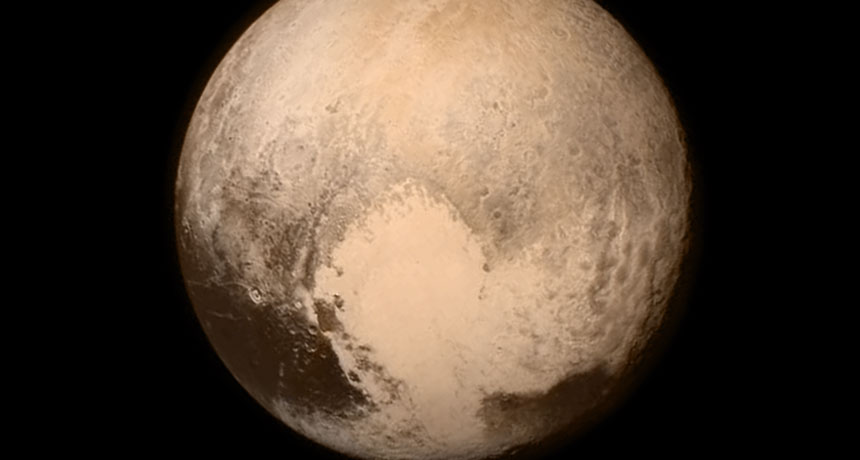Picture This: Pluto hearts us
The New Horizons spacecraft maintains radio silence as it focuses on snapping super-close-up features of the dwarf planet — like this heart-shaped one

This new photo of Pluto, snapped by the New Horizons spacecraft, shows a heart-shaped area on the surface of the dwarf planet.
JHUAPL, SWRI, NASA
Hello, Pluto.
Today, the New Horizons spacecraft whizzed by Pluto at just 12,500 kilometers (roughly 7,800 miles) above the dwarf planet’s surface. But it did so speedily — at nearly 50,000 kilometers (31,000 miles) per hour. It couldn’t send back images because the space probe was too busy focusing on collecting information. And to do that, it essentially had to keep its back to Earth.
Later, tonight, the probe will turn its antenna system back toward Earth and phone home to say: “Hello, Earth. I made it!” Or hopefully, anyway. A little later still, it should begin sending home true close-up shots of Pluto and its moons.
Meanwhile, here is a photo snapped before the spacecraft went into radio silence. It shows Pluto in full color. It was taken yesterday when New Horizons was 766,000 kilometers (476,000 miles) from the planet — and 16 hours from its closest approach. And in true 21st century fashion, NASA first released the image on Instagram.
It depicts a heart-shaped swath of bright terrain covering much of the bottom half of one side of the dwarf planet. It was first seen on July 8.
The resolution of the picture is about 1,000 times better than what the Hubble Space Telescope can provide from 5 billion kilometers away. But the really high-resolution pictures are yet to come!
The Pluto science team has only had a few hours to look at this image. Still, that isn’t stopping them from speculating about what they’re looking at.
“We see a history of impacts, a history of surface activity, and some features we might identify as tectonic — indicating internal activity at some time in the past,” said Alan Stern. He’s the mission’s principal investigator and was speaking at a news conference. “This is clearly a world where both geology and atmospheric climatology play a role,” he said.
There are no signs of plumes or hazes yet. But that doesn’t mean they’re not there, said Stern. And when asked if it snows on Pluto, he said: “Sure looks that way.”
Power Words
(for more about Power Words, click here)
climatology The study of weather conditions prevailing in an area in general or over a long period. Scientists who work in this field are called climatologists.
dwarf planet One of the solar system’s small celestial objects. Like a true planet, it orbits the sun. However, dwarf planets are too small to qualify as true planets. Prime examples of these objects: Pluto and Ceres.
geology The study of Earth’s physical structure and substance, its history and the processes that act on it. People who work in this field are known as geologists. Planetary geology is the science of studying the same things about other planets.
haze Fine liquid or solid particles scattered through the atmosphere that make it hard to see. Haze can be caused by harmful substances such as air pollutants or by water vapor.
moon The natural satellite of any planet.
plume (in chemistry) The movement of some gas or liquid, under the direction of gravity, winds or currents. It may be in air, soil or water. It gets its name from the fact that it tends to be long and relatively thin, shaped like a large feather.
Pluto A dwarf planet that is located in the Kuiper Belt, just beyond Neptune. Pluto is the tenth largest object orbiting the sun.
satellite A moon orbiting a planet or a vehicle or other manufactured object that orbits some celestial body in space.
solar system The eight major planets and their moons in orbit around the sun, together with smaller bodies in the form of dwarf planets, asteroids, meteoroids and comets.
tectonic Surface activity on a large rocky body (such as a planet or moon) as liquid rock flows up to the surface where it solidifies, then slowly drifts atop molten rock, carrying surface features with it.
telescope Usually a light-collecting instrument that makes distant objects appear nearer through the use of lenses or a combination of curved mirrors and lenses. Some, however, collect radio emissions (energy from a different portion of the electromagnetic spectrum) through a network of antennas.







